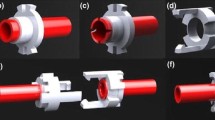Abstract
Background
Vascular anastomosis, which is usually performed during complex surgical procedures such as transplantation and reconstruction, is a time-consuming and skilled practice. The aim of this study is to compare the vascular anastomosis technique made with minimal suture and chitosan with the traditional technique.
Methods
Twenty adult female Wistar Albino rats were randomly divided into two groups, the control group (n = 10) in which the traditional hand-sewn technique was applied and the chitosan group (n = 10) with the minimal suture technique. The duration of anastomosis, patency rates on the first and 28th days, and histopathology of the vessels on the 28th day were evaluated.
Results
The mean duration of anastomosis was calculated as 19.18 ± 1.79 min in the control group and 11.30 ± 0.97 min in the chitosan group. The difference between the two groups was statistically significant (p < 0.001). There was no significant difference between the patency rates of the control and chitosan groups, both within group (between the 1st and 28th days) and between the groups by day. In histopathological examination, especially in the control group, transmural damage, foreign body reactions due to the suture material, and granulomas were observed around the suture, while perivascular foreign body reactions were observed less frequently in the chitosan group compared to the control group.
Conclusion
We have shown that this new method of microvascular anastomosis is effective, easy to learn, and requires less time than conventional sutures. However, other studies should be conducted to prove the feasibility of this new technique and to prove its long-term success and results in the vessels.


Similar content being viewed by others
References
Ducic I, Brown BJ, Rao SS (2011) Lower extremity free flap reconstruction outcomes using venous coupler. Microsurgery 31(5):360–364. https://doi.org/10.1002/micr.20888
Harii K, Omori S (1973) Use of the gastroepiploic vessels as recipient or donor vessels in the free transfer of composite flaps by microvascular anastomoses. Plast Reconstr Surg 52(5):541–548. https://doi.org/10.1097/00006534-197311000-00012
Eid A, Lyass S, Venturero M et al (1999) Vascular complications post orthotopic liver transplantation. Transplant Proc 31(4):1903–1904. https://doi.org/10.1016/s0041-1345(99)00148-7
Chang EI, Galvez MG, Glotzbach JP et al (2011) Vascular anastomosis using controlled phase transitions in poloxamer gels. Nat Med 17(9):1147–1152. https://doi.org/10.1038/nm.2424
Holt GP, Lewis FJ (1960) A new technique for end-to-end anastomosis of small arteries. Surg Forum 11:242–243
Kirsch WM, Zhu YH, Hardesty RA, Chapolini R (1992) A new method for microvascular anastomosis: report of experimental and clinical research. Am Surg 58(12):722–727
Kloppel M, Tudor C, Kovacs L et al (2007) Comparison of experimental microvascular end-to-end anastomosis via VCS-Clips versus conventional suture technique in an animal model. J Reconstr Microsurg 23(1):45–49. https://doi.org/10.1055/s-2006-958702
Stewart RB, Benbrahim A, LaMuraglia GM et al (1996) Laser assisted vascular welding with real time temperature control. Lasers Surg Med 19(1):9–16. https://doi.org/10.1002/(SICI)1096-9101(1996)19:1<9::AID-LSM2>3.0.CO;2-W
Saegusa N, Sarukawa S, Ohta K et al (2017) Sutureless microvascular anastomosis assisted by an expandable shape-memory alloy stent. PLoS ONE 12(7):e0181520. https://doi.org/10.1371/journal.pone.0181520
Kozen BG, Kircher SJ, Henao J, Godinez FS, Johnson AS (2008) An alternative hemostatic dressing: comparison of chitosan, HemCon, and QuikClot. Acad Emerg Med 15(1):74–81. https://doi.org/10.1111/j.1553-2712.2007.00009.x
Tan H, Ma R, Lin C, Liu Z, Tang T (2013) Quaternized chitosan as an antimicrobial agent: antimicrobial activity, mechanism of action and biomedical applications in orthopedics. Int J Mol Sci 14(1):1854–1869. https://doi.org/10.3390/ijms14011854
Klokkevold PR, Subar P, Fukayama H, Bertolami CN (1992) Effect of chitosan on lingual hemostasis in rabbits with platelet dysfunction induced by epoprostenol. J Oral Maxillofac Surg 50(1):41–45. https://doi.org/10.1016/0278-2391(92)90194-5
Kunio NR, Riha GM, Watson KM, Differding JA, Schreiber MA, Watters JM (2013) Chitosan based advanced hemostatic dressing is associated with decreased blood loss in a swine uncontrolled hemorrhage model. Am J Surg 205(5):505–510. https://doi.org/10.1016/j.amjsurg.2013.01.014
Alam HB, Burris D, DaCorta JA, Rhee P (2005) Hemorrhage control in the battlefield: role of new hemostatic agents. Mil Med 170(1):63–69. https://doi.org/10.7205/milmed.170.1.63
Pozza M, Millner RW (2011) chitosan (chitosan) for haemostasis in massive traumatic bleeding: experience in Afghanistan. Eur J Emerg Med 18(1):31–33. https://doi.org/10.1097/MEJ.0b013e32833a5ee4
Klein SL, Chen H, Israel-Graff J (1998) A comparison by burst testing of three types of vascular anastomosis. Microsurgery 18(1):29–32. https://doi.org/10.1002/(sici)1098-2752(1998)18:1<29::aid-micr7>3.0.co;2-p
Acland RD (1980) Preparation of microsurgery. In: Acland RD (Ed.). Microsurgey Practice Manual
Adams WP Jr, Ansari MS, Hay MT et al (2000) Patency of different arterial and venous end-to-side microanastomosis techniques in a rat model. Plast Reconstr Surg 105(1):156–161. https://doi.org/10.1097/00006534-200001000-00026
Aizawa T, Kuwabara M, Kubo S et al (2018) Sutureless microvascular anastomosis using intravascular stenting and cyanoacrylate adhesive. J Reconstr Microsurg 34(1):8–12. https://doi.org/10.1055/s-0037-1605587
Wadstrom J, Wik O (1993) Fibrin glue (Tisseel) added with sodium hyaluronate in microvascular anastomosing. Scand J Plast Reconstr Surg Hand Surg 27(4):257–261
Dai T, Tanaka M, Huang YY, Hamblin MR (2011) Chitosan preparations for wounds and burns: antimicrobial and wound-healing effects. Expert Rev Anti Infect Ther 9(7):857–879. https://doi.org/10.1586/eri.11.59
Dai T, Tegos GP, Burkatovskaya M, Castano AP, Hamblin MR (2009) Chitosan acetate bandage as a topical antimicrobial dressing for infected burns. Antimicrob Agents Chemother 53(2):393–400. https://doi.org/10.1128/AAC.00760-08
Author information
Authors and Affiliations
Contributions
HK conceived and designed the analysis; collected the data; contributed data or analysis tools; performed the analysis; and wrote the paper. HT conceived and designed the analysis; contributed data or analysis tools; performed the analysis; supervised the study; and critically reviewed the manuscript.
Corresponding author
Ethics declarations
Conflict of Interest
The authors declare no competing interests.
Additional information
Publisher's Note
Springer Nature remains neutral with regard to jurisdictional claims in published maps and institutional affiliations.
Rights and permissions
About this article
Cite this article
Kandulu, H., Top, H. Chitosan Effectiveness in End-to-End Vascular Anastomosis with Minimal Suture Technique. Indian J Surg 85 (Suppl 1), 259–264 (2023). https://doi.org/10.1007/s12262-021-03177-3
Received:
Accepted:
Published:
Issue Date:
DOI: https://doi.org/10.1007/s12262-021-03177-3




